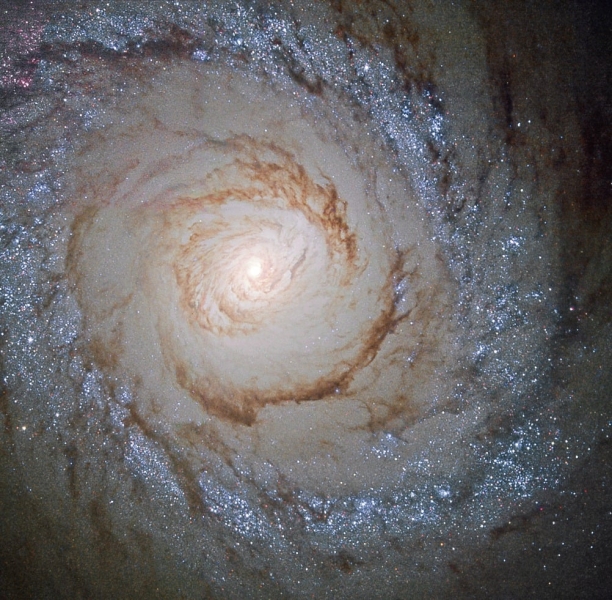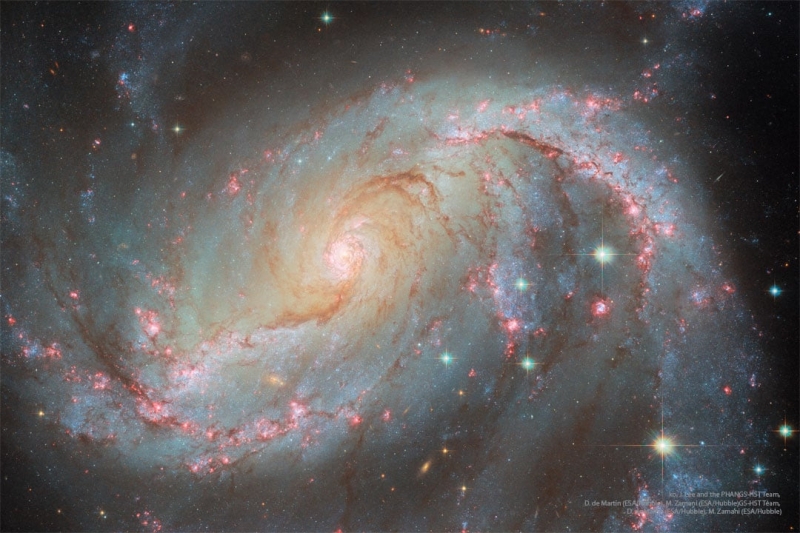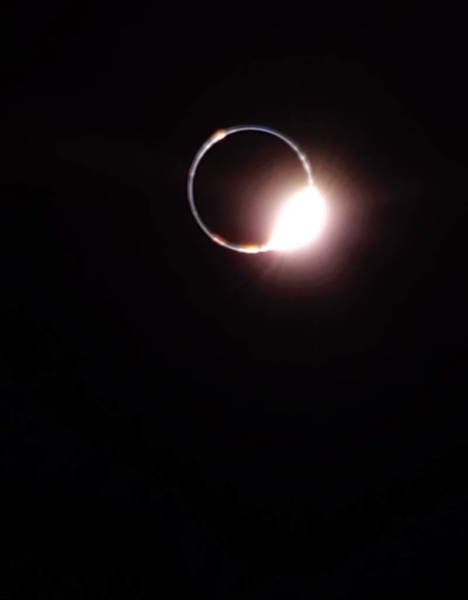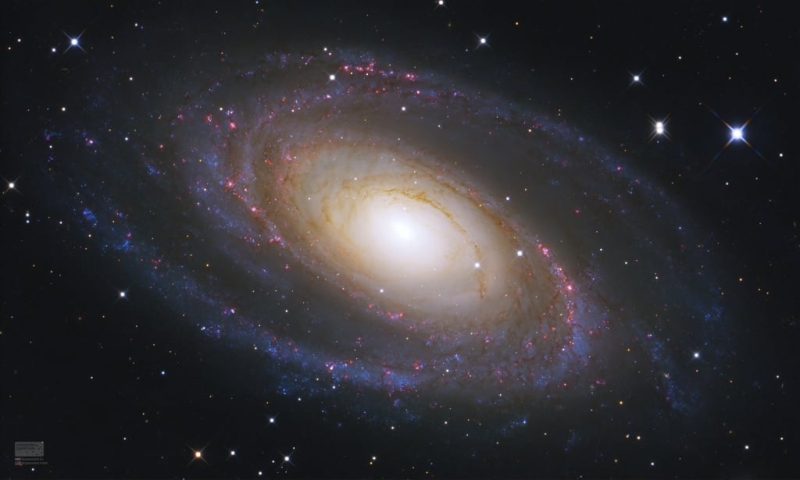Contents
NASA Astronomy Picture of the Day is a huge collection of astronomical images, both amateur and professional. It celebrates our amazing universe every day.
Since its inception in 1995, NASA APOD has been selecting and publishing some of the best images of space. Its two editors, Robert Nemiroff and Jerry Bonnell, are the people behind it. Here, you can see images taken with space telescopes like Hubble, JWST, etc. But it also includes amateur images taken with regular DSLR cameras.
Here are some of the best images from March 2025.
A Quadruple Alignment over Italy
Why is this Moon so strange-looking? Its striking red hue is a major factor. The colour results from the Earth’s atmosphere deflecting blue light, which is also the reason why the sky appears blue during the day. Additionally, the Moon seems oddly warped. Its peculiar structure is an optical phenomenon caused by layers in the Earth’s atmosphere that, as a result of abrupt variations in pressure or temperature, refract light in distinct ways. A third reason for the Moon’s strange appearance is that, coincidentally, an aeroplane is flying in front of it. Towards the end of February, a beautiful gibbous moon was photographed over Turin, Italy. Two historic ground structures, the Basilica of Superga just beyond and the Sacra di San Michele on the nearby hill, were part of an uncommon quadruple alignment that includes our famous hovering sky orb.

Image Credit & Copyright: Valerio Minato
Starburst Galaxy Messier 94
Messier 94 is located in Canes Venatici, the northern constellation of hunting dogs, at a distance of only 15 million light years. The face-on spiral galaxy, about 30,000 light-years across, is a popular target for terrestrial astronomers, with spiral arms running around the edges of its large disc. However, the Hubble Space Telescope’s field of view covers around 7,000 light-years over M94’s centre region. The sharp close-up focuses on the galaxy’s tight, brilliant centre and noticeable inner dust lanes, which are ringed by an impressive bluish ring of new, massive stars. The big stars in the ring appear to be less than 10 million years old, indicating that the galaxy had a well-defined period of fast star production.

Image Credit: ESA/Hubble and NASA
Galaxies in Space
In this space age exposure recorded by astronaut Don Pettit, the plane of our Milky Way galaxy extends beyond Earth’s limb. His camera, set to low light and long endurance, was pointed out the window of a Dragon crew spacecraft docked with the International Space Station on January 29. The orbiting outpost was approximately 400 km above the Pacific Ocean at the time. The Earth below is blurred by motion, but the stunning vista from low Earth orbit shows the Milky Way’s conspicuous satellite galaxies, known as the Large and Small Magellanic Clouds, in the upper left corner of the frame. Fans of the southern sky can also see the Southern Cross.

Image Credit & License: NASA, ISS Expedition 72, Don Petit
Cyclones at Jupiter’s North Pole
Why are there so many cyclones at Jupiter’s north pole? The topic is still being investigated. In 2018, NASA’s robotic Juno spacecraft circling Jupiter collected data that was utilised to create this breathtaking image of Jupiter’s mysterious cyclones at its north pole. Infrared observations measure the thermal emission from Jovian cloud tops and are not limited to the hemisphere lit by sunlight. They reveal eight cyclonic structures that surround a 4,000-kilometer-wide cyclone located just off the huge planet’s geographic north pole. Similarly, data suggest a cyclone at the Jovian south pole and five circumpolar cyclones. The south polar cyclones are slightly bigger than their northern counterparts.

Image Credit: NASA, JPL-Caltech, SwRI, ASI, INAF, JIRAM
NGC 1672: Barred Spiral Galaxy from Hubble
Many spiral galaxies contain bars in their centres. Even our own Milky Way Galaxy is believed to have a small core bar. The prominently barred spiral galaxy NGC 1672, seen here, was captured in amazing clarity in an image acquired by the orbiting Hubble Space Telescope. There are dark filamentary dust lanes, youthful clusters of bright blue stars, red emission nebulas of blazing hydrogen gas, a long bright bar of stars across the centre, and a bright active nucleus that most likely contains a supermassive black hole. Light takes about 60 million years to reach us from NGC 1672, which is approximately 75,000 light years wide.

Image Credit: ESA/Hubble & NASA, O. Fox, L. Jenkins, S. Van Dyk, A. Filippenko, J. Lee and the PHANGS-HST Team, D. de Martin (ESA/Hubble), M. Zamani (ESA/Hubble)
The Protostars within Lynds 483
This near-infrared image from the James Webb Space Telescope shows two protostars buried in a single pixel in the centre of an eye-catching hourglass-shaped nebula. The star system is actively forming in Lynds 483, a dusty molecular cloud located about 650 light-years away in the constellation Serpens Cauda. Over thousands of years, collapsing protostars have been blasting out collimated, intense jets of material, causing the magnificent bipolar outflows. Webb’s high-resolution image depicts the violence of star formation in vivid detail, as twisting shock fronts expand and smash with slower, denser material. The first close-up of the star-forming region in the dark nebula Lynds 483 covers less than half a light-year.

Image Credit: NASA, ESA, CSA, STScI
Tololo Totality
The moon was full on March 14. That placed the Moon 3.14 radians (180 degrees) from the Sun in the Earth’s sky, making it a fitting celebration of Pi Day. As an added benefit for those who enjoy both Pi and the night sky, the Moon also underwent a total lunar eclipse on that date, passing straight through Earth’s umbral shadow. The colours of an eclipsed Moon can be striking under clear skies. This time series composite image from Cerro Tololo Observatory, Chile, captured the darker lunar disc reflecting the intensely reddish sunlight scattered into Earth’s shadow. The beginning, middle, and end of the approximately one-hour total eclipse phase are depicted in the lunar triptych.

Image Credit & Copyright: Petr Horálek/CTIO (Cerro Tololo Observatory) /AURA/NSF/ NOIRLab
Blue Ghost’s Diamond Ring
Earth’s inhabitants witnessed a total lunar eclipse on March 14 as the Full Moon passed into the planet’s dark umbral shadow. Naturally, that same astronomical syzygy was perceived as a solar eclipse from the Moon’s near side. Around 3:30 am CDT, as the Sun was just coming out from behind the terrestrial disc, the Blue Ghost lander, which was operating in the Mare Crisium on the lunar surface, took this video frame of Earth in silhouette. The stunning diamond ring effect, which is well-known to those who watch solar eclipses on Earth, is remarkable when viewed from Blue Ghost’s lunar perspective. The inner solar corona, the Sun’s atmosphere that is most visible from Earth during a complete solar eclipse, is obscured by the lunar surface, which makes Earth appear roughly four times as large as the Sun. Nevertheless, the bright band of sunlight that envelops our lovely planet is the result of scattering in Earth’s thick atmosphere.

Image Credit: Firefly Aerospace
Messier 81
Messier 81 is a large, stunning galaxy that is comparable in size to our Milky Way Galaxy and is one of the brightest galaxies in the sky. This massive spiral is located towards the northern constellation of Ursa Major, the Great Bear, and is sometimes referred to as NGC 3031 or Bode’s galaxy after its discoverer in the 18th century. M81’s bright yellow centre, blue spiral arms, pinkish star-forming areas, and sweeping cosmic dust lanes are all visible in the crisp, precise telescopic image. However, in contrast to other notable spiral characteristics, some dust lanes cut across the galactic disc (left of centre). A close approach between M81 and the nearby galaxy M82, which is hiding outside of this frame, could be the cause of the misplaced dust lanes.

Image Credit & Copyright: Lorand Fenyes
A Partial Solar Eclipse over Iceland
What if the Moon and Sun rose at the same time? Shortly after daybreak on 29th March, a partial solar eclipse took place over certain northern regions of the planet Earth. Northeastern areas of North America and northwest parts of Europe, Asia, and Africa were among the regions where the Moon blocked a portion of the Sun. The highlighted image was taken yesterday over Iceland’s Grábrók volcanic crater, when the Moon briefly obscured a large portion of the Sun. Despite the overcast sky, the photographer’s pal meticulously prepared the shot so that it seemed as though the Sun was being pulled out from behind the Moon. This time, there was no total solar eclipse anywhere on Earth.

Image Credit & Copyright: Wioleta Gorecka
If you have a space image, you can submit it to NASA APOD, too.
For more incredible astrophotography photos, check our previous Breathtaking Astronomy Photos articles:
- Breathtaking Astrophotography Images – February 2025
- Breathtaking Astrophotography Images – January 2025
- Breathtaking Astrophotography Images – December 2024
- Breathtaking Astrophotography Images – November 2024
- Breathtaking Astrophotography Images – October 2024
- Breathtaking Astrophotography Images – September 2024
- Breathtaking Astrophotography Images – August 2024
Clear skies!

